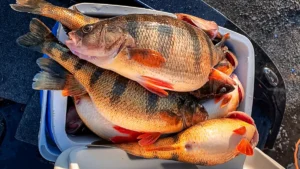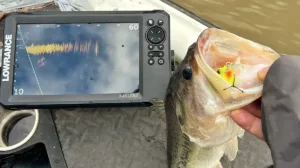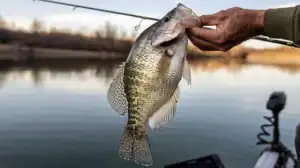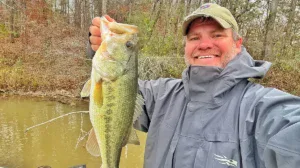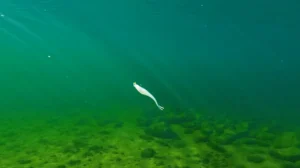Professional angler and Bass Pro Tour competitor Ott DeFoe is quick to grab his best spinnerbait when fishing springtime bass during cold and dirty water situations. Why? It’s a lure that fish can feel and see, and these days, it’s used less than bladed jigs and crankbaits, so bass are less conditioned to them. DeFoe shares 5 general spinnerbait fishing pointers covering the gamut from lure selection specifics like choosing blade configurations and when and why to target bass during the dirty, cold water of spring on warming trends. *Gear listing at the bottom.
DeFoe’s 5 tips for catching dirty water bass:
- Add a kicker blade (fluorescent orange or green). A little extra flash never hurts in off-colored water, and it gives DeFoe a little extra confidence. He also likes the increased visibility for his benefit of seeing the bait when fishing it just below the surface.
- Use a Colorado/Willow Blade combo. Blade selection can make a difference. Use spinnerbaits with an oversized willow-leaf blade and a smaller Colorado blade kicker. In addition to maximizing flash and vibration, the willow leaf provides essential lift in shallow water and has a shad-imitating profile.
- Fish during warming trends. There’s no better trigger for prespawn bass than the warming water temperatures of late winter and early spring. The base of the food chain activates, and in turn, predators like bass. If you’re not fortunate enough to be retired, go fishing when the water’s getting warmer — this usually means afternoons over mornings, and more broadly, local warming trends.
- Focus on the shallows. Shallow water warms the fastest, so the backs of creek arms, pockets, and coves are high-percentage areas. Always cast to visible hard cover like rocks, rock transitions, and any woody cover but don’t overlook subtle ditches or even featureless flats. Shad are roamers, and so to can be the bass.
- Mind your mapping. We filmed this video on Douglas Lake (Ott’s home water), which experiences wide fluctuations in water level. DeFoe uses LakeMaster’s Water Level Offset to maintain an accurate bottom picture by adjusting contours to current water levels. He then sets his Shallow Water Highlight to reveal essential flats and easy-to-overlook bottom subtleties like ditches and troughs. Bottom line, know what’s around you, fish it all, determine what bass are relating to, and run a pattern.
TACKLE AND GEAR
- LURE – Terminator P1 Pro Series Tandem Spinnerbait, 1/2-ounce
- TRAILER – Bass Pro Shops Cajun Trailer, color – Blue Glimmer
- ROD – Bass Pro Shops Johnny Morris CarbonLite 2.0 Casting Rod, 7′ Medium-Heavy
- REEL – Bass Pro Shops Johnny Morris CarbonLite 2.0 Casting Reel, 6.8:1
- LINE – Bass Pro Shops XPS KVD Signature Fluorocarbon, 17-pound
OTHER GEAR
- FISH FINDER – Humminbird HELIX 12 CHIRP MEGA SI+ GPS G4N
- MAPPING – LakeMaster Southeast States PLUS V3
- 360 SONAR – Humminbird MEGA 360 Imaging
- TROLLING MOTOR – Minn Kota Ultrex
- SUNGLASSES – Costa Del Mar Fathom


![[VIDEO] Greg Hackney’s Formula for Post-Spawn Bass Success](https://www.wired2fish.com/wp-content/uploads/2025/05/Hackney_Post-Spawn_Bass-300x169.webp)
![[VIDEO] Scanlon’s Guide for Stained Water Spawning Bass](https://www.wired2fish.com/wp-content/uploads/2025/05/scanlon-jig-300x169.webp)
![[VIDEO] Seth Feider’s Prespawn Jig Pattern Explained](https://www.wired2fish.com/wp-content/uploads/2025/04/prespawn-jig-300x169.webp)
